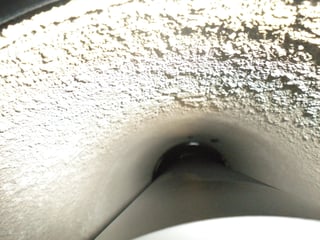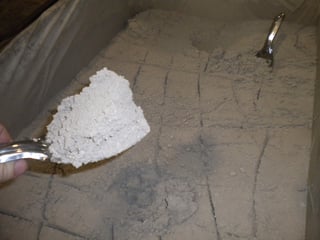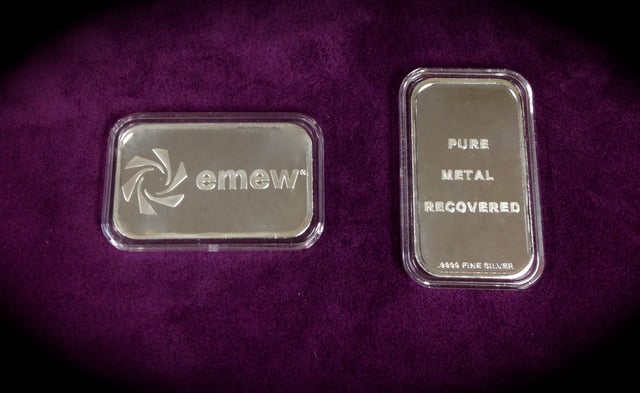While silver is definitely a precious metal, the usages of this metal are much wider than just the jewelry industry. Silver is a great electro-conductor which makes it a beneficial metal in the manufacturing of electrical and electronic components. Silver is a cost-effective and high-performance metal for the electronics industry. For example, it can be used in copper or brass connectors in order to increase conductivity. In other cases, silver is used as an anti-tarnishing plating and can prevent scratches and retain the attractiveness of parts.
"The future will either be green or not at all."
~ Bob Brown
In mining applications, electrowinning is used to recover silver and gold from cyanide-based leach solutions. The precious metals are first dissolved or "leached" from the ore or concentrate into a solution using cyanide. The leach solution loaded with gold or silver is known as Pregnant Leach Solution or PLS. Electrowinning is then used to recover the metals in pure form by applying a voltage in a cell containing PLS as the electrolyte. Due to its reactivity and place on the electrochemical series, silver is electrodeposited with gold in preference to many other base metals. If the concentration of silver is roughly equal to or greater than gold in the PLS, the silver can actually be used as a collector to facilitate the electrodeposition of gold. The resulting deposit is a gold-silver alloy.
Electrowinning is also used in the refining industry to produce high purity silver from low-grade residues and scrap materials. Electrorefining is another common method used in refining applications but first requires that an impure silver anode is cast from the feed material. Electrorefining is very similar to electrowinning, the difference being that in electrorefining the anode itself consists of impure metal that has to be purified, while in electrowinning the anode is inert. Electrowinning can also be used to control silver concentration in electrorefining since the process of electrodissolution is always more efficient than electroplating resulting in a build-up of metal in solution over time. Silver refining usually uses nitric acid as the electrolyte owing to its ability to readily dissolve silver and its high conductivity.
FREE Download - Silver Recovery Brochure
To download fill the form below
As modern technologies grow, so does the amount of electronic waste or e-waste. Electrowinning of silver plays a key role in these environmental applications. Since metals are endlessly recyclable, many companies are now recovering silver and other precious metals from electronic waste in favour of disposing of in landfill. Processes are well known to extract silver and other valuable metals from a variety of e-waste and waste electric and electronic equipment (WEEE). These processes usually involve crushing and grinding, gravity and magnetic separation, leaching and purification. The last two stages (i.e. leaching and purification) are where electrowinning comes to play. The result is the recovery and reuse of high purity metals from these so called 'urban mines'.
Electrowinning is also used for the creation of metal powders. While the solid metal plate is the form most often associated with electrowinning, high purity powders can also be produced using the same method. Electrolytic powder after all is just a poorly formed cathode or a different crystal structure. In the process of electrowinning, the silver powder is electroplated onto the cathode and harvested into collection reservoirs. The harvesting process can either be manual or automatic depending on the electrowinning technology employed. Automatic harvesting is a more secure method that ensures significantly fewer losses and easier accounting of the precious metal.

There is also a negative side of using silver (and other metals) in manufacturing processes. For example, in electroplating and metal finishing industries, water baths are used to rinse the finished parts. In this process, water is used for a limited amount of times and has to be precipitated or disposed of because the concentration of silver builds up with continued use. Wastewater that contains silver complexed with cyanide cannot just be disposed of in municipal water systems or rivers. This wastewater is extremely toxic and must either be disposed of by a third-party contractor or treated locally. In order to dispose of wastewater from the site, manufacturers often pay a significant amount to third-party waste disposal companies. While this method of waste treatment is convenient since no local process is required and no additional space is occupied, companies lose a lot of money every year just by not wanting to recover silver from effluent treatment. Electrowinning on the other hand helps to recover the silver from rinse baths and other wastewaters so that it can be recycled and reused within the process or sold to offset treatment costs. Electrowinning can also be used to control the concentration of silver in plating baths.

Treatment of wastewater that contains silver can be done using a variety of techniques including continuous recovery systems such as emew (I explained the basics of electrowinning in a previous post Electrowinning 101: What is electrowinning?). Setting it apart from other technologies, emew electrowinning helps to maximize metal recovery and improve the purity of extracted silver to 99.99% and beyond. Since conventional electrolysis processes are susceptible to impurities such as lead, cadmium, selenium, tellurium, and others that wind up in the silver product, emew can be used to produce high purity silver even in the presence of high concentrations of many impurities. For non-refiners (i.e. miners, waste processors, recyclers, etc) silver produced in this way is cheaper to refine since refinery tolls increase as the amount of impurities increase. This means that the recovered silver can be sold for a higher price with fewer penalties from refiners. An additional benefit of silver recovery with emew electrowinning is that the electrowinning cell doesn’t have to be opened in order to harvest the metal. Silver will have a powdery form and the deposit is automatically flushed out of the cell to a secure collection vessel. Not only does this facilitate metallurgical accounting but also increases security and minimizes losses.

So, in simple terms, how does an emew electrowinning powder system operate? During regular operation, electrolyte containing dissolved silver is circulated from a feed tank through the emew electrowinning cells to which an electrical current is applied. Silver powder deposits onto the cathode as the electrowinning progresses over time. After a set period, the current is stopped and the solution flow is periodically reversed at a higher flow rate to strip the electro-deposited silver powder from the cathode and into a secure collection tank, from which the silver powder is then separated from the electrolyte using a filter or hydrocyclone. After a short flush cycle, the solution flow and current return to their normal mode of operation.
Sources:
http://www.rwaterguy.com/removal_of_silver_from_wastewate.htm
https://health.howstuffworks.com/wellness/diet-fitness/information/question565.htm
http://infohouse.p2ric.org/ref/25/24763.pdf






